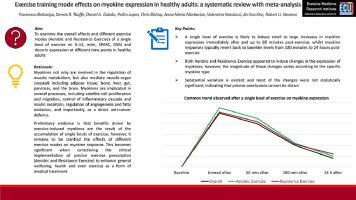当前位置:
X-MOL 学术
›
J. Sport Health Sci.
›
论文详情
Our official English website, www.x-mol.net, welcomes your
feedback! (Note: you will need to create a separate account there.)
Exercise training mode effects on myokine expression in healthy adults: A systematic review with meta-analysis
Journal of Sport and Health Science ( IF 9.7 ) Pub Date : 2024-04-10 , DOI: 10.1016/j.jshs.2024.04.005 Francesco Bettariga 1 , Dennis R Taaffe 1 , Daniel A Galvão 1 , Pedro Lopez 2 , Chris Bishop 3 , Anna Maria Markarian 1 , Valentina Natalucci 4 , Jin-Soo Kim 1 , Robert U Newton 5
Journal of Sport and Health Science ( IF 9.7 ) Pub Date : 2024-04-10 , DOI: 10.1016/j.jshs.2024.04.005 Francesco Bettariga 1 , Dennis R Taaffe 1 , Daniel A Galvão 1 , Pedro Lopez 2 , Chris Bishop 3 , Anna Maria Markarian 1 , Valentina Natalucci 4 , Jin-Soo Kim 1 , Robert U Newton 5
Affiliation

|
The benefits of exercise are well known; however, many of the underlying molecular mechanisms are not fully understood. Skeletal muscle secretes myokines, which mediate muscle–organ crosstalk. Myokines regulate satellite-cell proliferation and migration, inflammatory cascade, insulin secretion, angiogenesis, fatty oxidation, and cancer suppression. To date, the effects of different exercise modes (namely, aerobic and resistance exercise) on myokine response remain to be elucidated. This is crucial considering the clinical implementation of exercise to enhance general health and wellbeing and as a medical treatment. A systematic search was undertaken in PubMed, MEDLINE, CINAHL, Embase, SPORTDiscus, and Web of Science in April 2023. Eligible studies examining the effects of a single bout of exercise on interleukin15 (IL-15), irisin, secreted protein acidic and rich in cysteine (SPARC), oncostatin M (OSM), and decorin were included. A random-effects meta-analysis was also undertaken to quantify the magnitude of change. Sixty-two studies were included ( = 1193). Overall, exercise appeared to induce small to large increases in myokine expression, with effects observed immediately after to 60 min post-exercise, although these were mostly not statistically significant. Both aerobic and resistance exercise resulted in changes in myokine levels, without any significant difference between training modes, and with the magnitude of change differing across myokines. Myokine levels returned to baseline levels within 180 min to 24 h post-exercise. However, owing to potential sources of heterogeneity, most changes were not statistically significant, indicating that precise conclusions cannot be drawn. Knowledge is limited but expanding with respect to the impact of overall and specific effects of exercise on myokine expression at different time points in the systemic circulation. Further research is required to investigate the effects of different exercise modes at multiple time points on myokine response.
中文翻译:

运动训练模式对健康成人肌因子表达的影响:荟萃分析的系统评价
运动的好处众所周知;然而,许多潜在的分子机制尚未完全了解。骨骼肌分泌肌因子,介导肌肉器官串扰。肌因子调节卫星细胞增殖和迁移、炎症级联、胰岛素分泌、血管生成、脂肪氧化和癌症抑制。迄今为止,不同运动模式(即有氧运动和抗阻运动)对肌因子反应的影响仍有待阐明。考虑到临床实施运动以增强总体健康和福祉以及作为一种医疗手段,这一点至关重要。 2023 年 4 月,在 PubMed、MEDLINE、CINAHL、Embase、SPORTDiscus 和 Web of Science 上进行了一项系统检索。符合条件的研究检验了单次运动对白细胞介素 15 (IL-15)、鸢尾素、酸性分泌蛋白和丰富蛋白的影响包括半胱氨酸 (SPARC)、制瘤素 M (OSM) 和核心蛋白聚糖。还进行了随机效应荟萃分析来量化变化的幅度。纳入 62 项研究 (= 1193)。总体而言,运动似乎会诱导肌因子表达从小到大的增加,在运动后立即观察到运动后 60 分钟的效果,尽管这些效果大多不具有统计学意义。有氧运动和抗阻运动都会导致肌因子水平发生变化,训练模式之间没有任何显着差异,而且不同肌因子的变化幅度也不同。运动后 180 分钟至 24 小时内肌因子水平恢复至基线水平。然而,由于潜在的异质性来源,大多数变化在统计上并不显着,这表明无法得出精确的结论。 关于运动对体循环不同时间点肌因子表达的总体和特定影响的影响,知识有限,但正在不断扩展。需要进一步的研究来调查多个时间点不同运动模式对肌因子反应的影响。
更新日期:2024-04-10
中文翻译:

运动训练模式对健康成人肌因子表达的影响:荟萃分析的系统评价
运动的好处众所周知;然而,许多潜在的分子机制尚未完全了解。骨骼肌分泌肌因子,介导肌肉器官串扰。肌因子调节卫星细胞增殖和迁移、炎症级联、胰岛素分泌、血管生成、脂肪氧化和癌症抑制。迄今为止,不同运动模式(即有氧运动和抗阻运动)对肌因子反应的影响仍有待阐明。考虑到临床实施运动以增强总体健康和福祉以及作为一种医疗手段,这一点至关重要。 2023 年 4 月,在 PubMed、MEDLINE、CINAHL、Embase、SPORTDiscus 和 Web of Science 上进行了一项系统检索。符合条件的研究检验了单次运动对白细胞介素 15 (IL-15)、鸢尾素、酸性分泌蛋白和丰富蛋白的影响包括半胱氨酸 (SPARC)、制瘤素 M (OSM) 和核心蛋白聚糖。还进行了随机效应荟萃分析来量化变化的幅度。纳入 62 项研究 (= 1193)。总体而言,运动似乎会诱导肌因子表达从小到大的增加,在运动后立即观察到运动后 60 分钟的效果,尽管这些效果大多不具有统计学意义。有氧运动和抗阻运动都会导致肌因子水平发生变化,训练模式之间没有任何显着差异,而且不同肌因子的变化幅度也不同。运动后 180 分钟至 24 小时内肌因子水平恢复至基线水平。然而,由于潜在的异质性来源,大多数变化在统计上并不显着,这表明无法得出精确的结论。 关于运动对体循环不同时间点肌因子表达的总体和特定影响的影响,知识有限,但正在不断扩展。需要进一步的研究来调查多个时间点不同运动模式对肌因子反应的影响。
















































 京公网安备 11010802027423号
京公网安备 11010802027423号